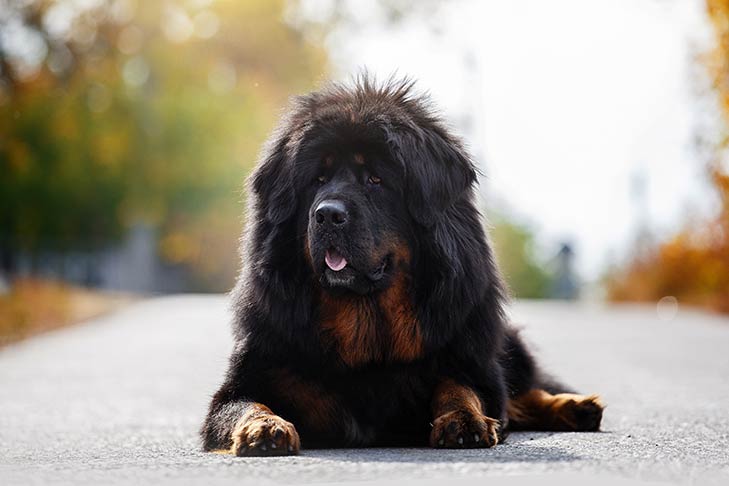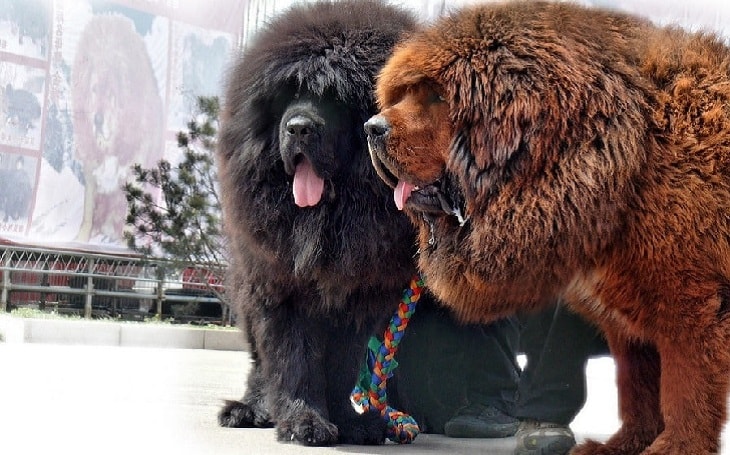Last Updated on February 11, 2024 by Fumipets
Decoding the Investment: How Much Does a Tibetan Mastiff Cost?
Owning a Tibetan Mastiff, an ancient and majestic breed known for its impressive size and noble appearance, is a dream for many dog enthusiasts. However, the allure of this remarkable canine companion often comes with a significant price tag.
In this exploration, we delve into the factors that influence the cost of a Tibetan Mastiff and unravel the considerations prospective owners should bear in mind when embarking on the journey to bring this regal breed into their homes.
Tibetan Mastiff Cost
| Height: | 26 inches (male), 24 inches (female) |
| Weight: | 90 – 150 pounds (male), 70 – 120 pounds (female) |
| Lifespan: | 10 – 12 years |
| Colors: | Red-gold, brown, black and tan, black, blue-gray, red gold sable, blue-gray and tan, brown and tan, blue-gray and tan |
| Suitable for: | Experienced dog owners, families without young children, other dogs of the opposite sex, people wanting an indoor watchdog |
| Temperament: | Independent, intelligent, territorial, reserved, calm, stubborn, devoted to family |
Tibetan Mastiffs are purebred canines that are large and muscular, making them ideal guard dogs. Males may grow to be 26 inches tall and weigh up to 150 pounds. These ancient canines originated in Tibet approximately 1,100 BC, according to one of the few historical sources regarding Tibetan Mastiffs. They were raised as guard dogs and watchdogs to safeguard Tibetan villages’ and nomads’ livestock and property in the Himalayas. With their lion-like manes and double-coated, thick fur, they stand out from any other dog.
Don’t let their bulk fool you about their agility; they’re swift on their feet and will protect their territory if a danger emerges. They are bright, yet they may be resistant when it comes to training. They are also devoted to their owners. Continue reading to learn more about this ancient and massive dog breed.
Before You Buy…
Keep in mind that when the charming little Tibetan puppy reaches maturity, it will grow to a huge size. Males may weigh up to 150 pounds, so be prepared to share your home with a canine the size of another person. This breed is worth considering if you’re looking for a watchdog. Because of its big size, this breed is not suitable for apartment dwellers.

What’s the Price of Tibetan Mastiff Puppies?
Tibetan Mastiff pups are incredibly uncommon and difficult to come by in the United States, but if you do find one, prepare to spend between $1,500 and $5,000. They are quite pricey due to their scarcity. To put it in perspective, they are the world’s most expensive dog breed.
3 Little-Known Facts About Tibetan Mastiffs
1. They have wolf genes.
Tibetan Mastiffs flourish in the Himalayan Mountains for a reason. Because they contain a few wolf genes, Tibetan Mastiffs are at ease at high elevations. Tibetan villagers kept these dogs as pets and to defend their sheep herds at elevations of 15,000 feet and higher. Due to a lack of oxygen, most dogs lack this capacity, but the Tibetan Mastiff is well adapted to tolerate such high elevations.
According to research, Tibetan Mastiffs have a protein on their red blood cells that transports oxygen at a 50% higher rate than other dog breeds, enabling them to thrive at high elevations. Any other breed of dog, on the other hand, would die. Tibetan Mastiffs and Mountain Wolves are thought to have mated at some time in order to live at such high elevations, according to scientists.

2. Female Tibetans go into heat only once a year.
Other dog breeds’ females go into heat twice a year, perhaps three for smaller dogs, while the Tibetan Mastiff’s female does not. The cycle normally starts in the autumn, and Tibetan Mastiff pups are born in December and January every year.
3. A Tibetan Mastiff was sold for $1. 5 million.
A 1. 5 million dollar sale was made on a red Tibetan Mastiff known as “Big Splash” across the globe. In 2011, a rich Chinese businessman footed the cash for the dog. The Tibetan Mastiff weighed a massive 180 pounds at 11 months old.
Another Tibetan Mastiff sold for $2 million at a Chinese “luxury pet expo” in Zhejiang, if you can believe it. The Tibetan Mastiff is a sign of success and money in China, therefore if you have millions of dollars laying around, you may buy a Tibetan Mastiff and join the elite.
Tibetan Mastiff Temperament and Intelligence
The Tibetan Mastiff is a smart, loyal, and protective dog. Because they were raised to be guard dogs and watchdogs, they have strong protective instincts. It’s crucial to understand that this breed has a strong independent streak and isn’t recommended for first-time dog owners. This breed is also known for its stubbornness, which makes training difficult. You, the owner, will require prior leadership experience with this breed, which should begin while they are puppies.
They are peaceful dogs that only display hostility when necessary. The Tibetan Mastiff will bark so loudly that you will most likely jump if a stranger approaches your home. Their bark is loud and strong, and any intruder who comes face to face with this gigantic beast would most certainly run. When new people come over, it may be a bit of a problem, and you’ll need to have a tight grasp on the situation. When the Tibetan Mastiff recognizes that the newcomer poses no danger, they will lower their guard.
Given the appropriate house, the right owner, and the proper surroundings, these dogs will create a close attachment with their owners. They will go to great lengths to defend individuals they care about, and they make wonderful watchdogs.
Are These Dogs Good for Families?
These dogs make excellent family pets, but they are not suitable for families with little children. The Tibetan Mastiff may be confused by tiny children’s shouts and yells, and it may perceive the sounds as a danger, prompting a call to action. To prevent this, kids must be socialized and exposed to small children from an early age.
They are loyal and affectionate family dogs that will build a close attachment with you after they have gained your confidence. This breed is not suited to a household with a lot of screaming or fighting. This will be seen as a threat, and they will become combative. Due to their intransigence and independence, they are not suited for first-time owners.

Is this breed good with other Pets?
They get along with other pets, however having dogs of opposite sexes in the house is preferred. Having two males or two females together, for example, will be difficult and stressful if early socialization is not practiced. However, if your Tibetan Mastiff was raised with other dogs and you perform consistent, supervised socialization, your Tibetan Mastiff can and will get along with other pets.
What to Know Before Getting a Tibetan Mastiff:
Food & Diet Requirements
Despite their gigantic size, the Tibetan Mastiff does not consume as much food as one would expect. They can get by on 4-5 cups of high-quality kibble each day, split into two meals. Because of their history of living in Tibet, where food was sparse, some scientists think they can take fewer diets. Puppies will need more food on a regular basis, around three meals each day.
Exercise
The Tibetan Mastiff does not need a lot of exercise. They do, however, need moderate daily activity, which generally takes the shape of exploring their area or taking on other responsibilities. They’re members of the Working Group, thus they don’t play fetch; instead, they’re content with work-related chores.
It’s also a good idea to take your Tibetan Mastiff for regular walks twice a day for exercise. Because the Tibetan Mastiff is territorial, you’ll want to modify your path often to avoid their becoming defensive. To guarantee their safety, they must be kept on a leash at all times. A fenced yard is also excellent so they may run about freely.
Training
These dogs are bright, but they may be resistant when it comes to typical training techniques. They are not motivated by rewards and will disregard directives they believe they already know since there is no need to repeat them. They learn rapidly, however some have been known to perform well in a training session before entirely disregarding their owner’s directions once they get home.
They are self-sufficient and may believe they do not need your assistance. They may form bonds with their human companions, but it does not guarantee that they will always follow you.
Because of their independence, you’ll need to be patient with them throughout training. Nonetheless, if they appreciate and trust their owner, they’ll be relatively obedient, create a close attachment, and risk their lives to defend you.
Grooming
During the autumn and winter, grooming Tibetan Mastiffs shed very little, but shedding rises in the spring and summer. Grooming needs are surprisingly low because of the densely covered, coarse hair. Once a week is usually plenty, and you’ll want to use a slicker brush for the best results. An undercoat rake or de-shedding equipment works best when shedding is at its peak in the spring and summer.
Health and Conditions
All dogs are susceptible to a variety of health issues. While the Tibetan Mastiff is a generally healthy breed, there are a few health issues to be aware of.
While the Tibetan Mastiff is a generally healthy breed, there are a few health issues to be aware of.
· Severe Conditions:
Hip and Elbow Dysplasia: These are hereditary diseases that are more prevalent in big breed dogs. They are skeletal conditions in which the joint’s ball and socket do not fit correctly. These illnesses are very unpleasant, and poor diet and weight control may exacerbate the predisposition.
Canine Inherited Hypertrophic Neuropathy: After weaning, about 7 to 10 weeks of age, this neuropathy was observed in Tibetan Mastiff puppies. Loss of bark, weakening in the limbs, and slowed reflexes are all symptoms. They will have sensory abilities, yet they may be unable to walk. This illness has no known cure.
· Minor Conditions:
Hypothyroidism: A disorder that affects medium to big breed dogs and generally occurs between the ages of four and ten. Weight gain occurs when the thyroid gland does not generate adequate thyroid hormones. A poor coat, dry skin, excessive shedding, tiredness, and inactivity are all possible symptoms. Although there is no cure, the illness may be managed with the help of your veterinarian.
Entropion: A disorder in which the upper eyelid slides inward and rubs on the cornea. To fix the problem, surgery is necessary. The condition may need many procedures to fix, but the prognosis is favorable.
Ectropion: A is a disorder in which the lower eyelid rolls outward and droops. It may induce conjunctivitis and cause a lot of discomfort. The most common therapy is lubricating drops. In extreme circumstances, surgery may be necessary.
Minor Conditions
• Hypothyroidism
• Entropion
• Ectropion
Serious Conditions
• Hip Dysplasia
• Elbow Dysplasia
• Canine Inherited Hypertrophic Neuropathy

Females vs. Males
Males are somewhat larger than females, but only by a little margin. A girl may weigh up to 120 pounds and stand 24 inches tall (males reach up to 150 pounds with a height of 26 inches). Males are more aggressive than females, while females are more friendly. Females grow sooner and are more loving than men.
Conclusion
While this breed makes a great watchdog, it isn’t for everyone. These dogs need a good handle on training, and they are not appropriate for first-time dog owners. They are self-sufficient, territorial, quiet (until provoked), reserved, and tenacious. They get along well with other pets if they’re socialized early on, and if they trust you, they build close ties with their family members.
Because of their intransigence and sensitive side, Tibetan Mastiffs need obedience training, but with patience, dedication, and commitment, they can provide a great deal of security, as well as loyalty and affection, to your family.
Q&A: Unraveling the Expenses of Tibetan Mastiff Ownership
What factors contribute to the cost of a Tibetan Mastiff?
The price of a Tibetan Mastiff is influenced by various factors, including the dog’s lineage, pedigree, age, and the reputation of the breeder. Exceptional bloodlines, health certifications, and desirable coat colors often contribute to a higher price.
What is the average cost range for a Tibetan Mastiff?
The cost of a Tibetan Mastiff can vary widely, ranging from $2,000 to $5,000 or more. Exceptional lineage, health checks, and other premium factors can drive the price even higher, with some Tibetan Mastiffs fetching prices in the tens of thousands.
Are there ongoing expenses associated with Tibetan Mastiff ownership?
Beyond the initial purchase price, owning a Tibetan Mastiff entails ongoing expenses such as high-quality dog food, grooming supplies, veterinary care, and potential training sessions. Understanding and budgeting for these recurring costs is essential for responsible ownership.
What health considerations should potential owners be aware of?
Tibetan Mastiffs are generally healthy dogs, but like any breed, they can be prone to certain health issues. Responsible breeders conduct health screenings for common conditions, and potential owners should inquire about these screenings. Regular veterinary check-ups and preventive care are crucial for maintaining the well-being of these magnificent dogs.
How can prospective owners find reputable breeders and avoid scams?
To ensure a healthy and ethically bred Tibetan Mastiff, prospective owners should research and choose reputable breeders with a history of responsible breeding practices. Avoiding online scams, checking references, and visiting the breeder’s facilities are essential steps in finding a trustworthy source for acquiring a Tibetan Mastiff.


















